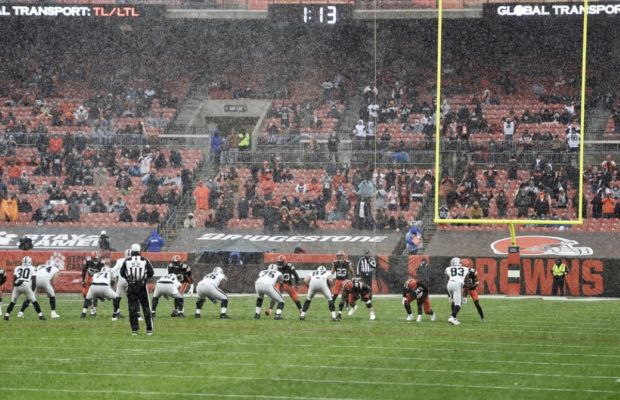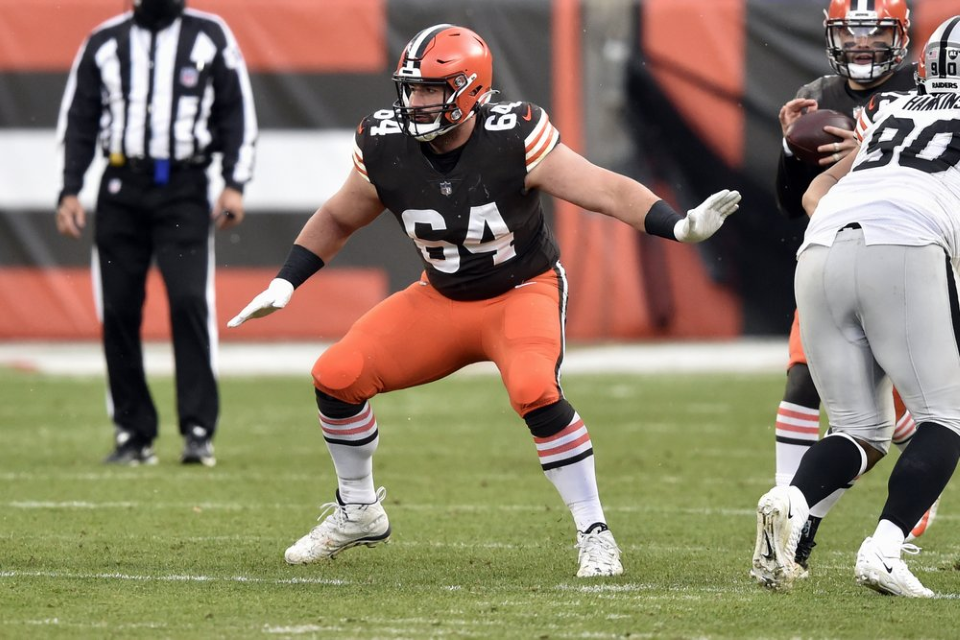Keeping NFL playing surfaces safe, grass or not

The sight of players slipping and sliding on the natural grass field in Cleveland last Sunday was comical to some, disturbing to others. After all, it was only the first day of November, yet a wintry blast had hit the NFL.
As the calendar moves forward and Mother Nature does her thing, the quality of the playing surfaces will come into play more and more. Sure, that doesn’t seem like a big deal for indoor facilities using synthetic turf such as Houston or Indianapolis or Minnesota. But, as a 2019 study published in the American Journal of Sports Medicine points out, “playing on artificial turf increases the risk of lower body injury and that field surface has a causal effect on injury rates due to synthetic turf’s lack of ability to release an athlete’s shoe.”
And Browns center JC Tretter, president of the players’ union, has called for all NFL stadiums to put in natural grass fields; this season, 17 stadiums have it, while 13 have synthetic surfaces.
Regardless of what the games are played on, the most important duty — particularly as we move through November into December — is ensuring they are in the best shape possible.
“It’s all about safe athletic surfaces for any user, and that’s what we focus on from an education standpoint,” says Jimmy Simpson, the president of the Sports Turf Managers Association. His organization includes 32 local chapters and 2,700 field managers for all levels of sports: schools, colleges, parks and recreational facilities, and professional sports.
“We try to treat them all the same, looking for safe footing for all athletes, from the pros to Little League Baseball. Devoid of ruts and holes, surfaces with as much grass on top as they can have, with good ball roll. A predictable surface to perform each and every time. The more consistent the surface, the safer the surface, and the athlete can trust their abilities and let their abilities shine.
“Our managers don’t want our surfaces to affect a game, for any athlete of any age or experience or level of play.”
At the highest level, where money should be no object, there still can be controversy. The 49ers lost several players, including 2019 Defensive Rookie of the Year Nick Bosa, in Week 2 at MetLife Stadium, which has Field Turf Classic HD. The NFL re-examined and recertified the field after that game.

Cleveland Browns center JC Tretter (64) blocks during an NFL football game against the Las Vegas Raiders in Cleveland Photo AP Photo/David Richard, File
Generally, though, the impact surfaces have on the games has been minimized compared to the earlier days of artificial turf that was almost like playing on cement. There’s always the infamous story of Bears receiver Wendell Davis, who tore the patellar tendons in both knees on the same play at Veterans Stadium in Philadelphia in 1993.
“We have an independent field inspector who is not on a club or the NFL side and they do a report and a certification and review of all our surfaces,” explains Phil Bogle, the league’s director of game operations. “We inspect them every season, then do our reviews and there are numbers weekly entered by the field manager.
“Throughout the season, you have climate as a big thing, depending on the surface and the use of the surface. Our field management requires mandatory practices for both natural and synthetic surfaces, and criteria all teams must meet on a weekly basis.”
As the weeks proceed toward plummeting temperatures, snow, freezing rain and whipping wind, it’s critical that those field managers keep up. Even in such places as Arizona and Las Vegas, which use grass fields for indoor stadiums, diligence in keeping those surfaces up to standards is essential.
But the focus almost always is on the places like Buffalo (A-Turf Titan), New England (Field Turf) and Cincinnati (Twenty-Four/Seven synthetic) as well as the grass of Denver, Kansas City, Chicago and Green Bay. Quite a few of the grass fields have heating systems underneath them to prevent freezing. Even MetLife Stadium, a synthetic turf, added such a system this year.
Bogles adds that some teams have covered the fields with a tarp and pumped heat underneath the tarp to keep the surface from freezing.
“For synthetic throughout the year, they groom the field, do whatever they need to groom it to add the (crumb rubber),” says Dave Gardi, the NFL’s senior vice president of football operations. “For grass, trying to maintain grass, whether it is in Florida versus Chicago, they will certainly re-sod in Florida, but maybe not as often because it’s easier to grow grass. Chicago might have to re-sod a few times and that is done under our football operations with specific rules in place.”
The STMA’s Simpson says that if the NFL decided it wanted all fields to be grass, as Tretter suggested they should, his organization could help make it happen.
“There are enough suppliers out there,” Simpson says. “We hope fields at all levels have a professional sports field manager who can provide insight for coaches and players and owners for all levels. We recommend working with the scientists and continue to work on field surfaces at the pro, college and local youth clubs.
“We would love to get to a point where the scientists and athletes and team owners can agree what the best surfaces are to play on.”
___